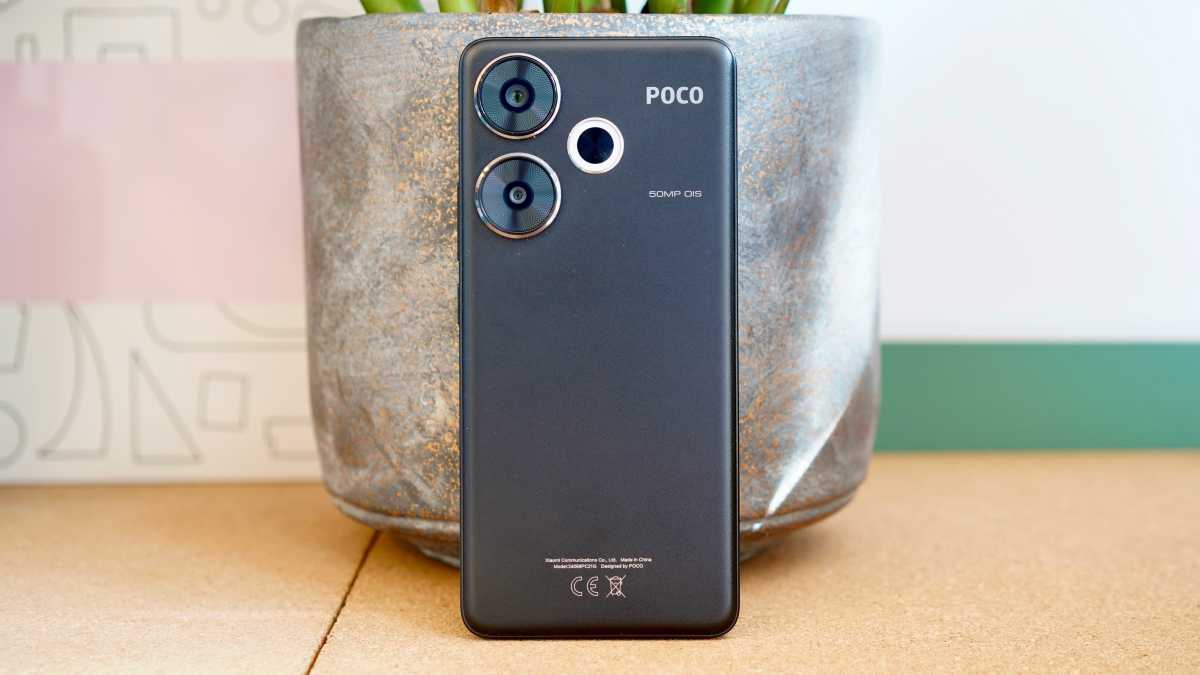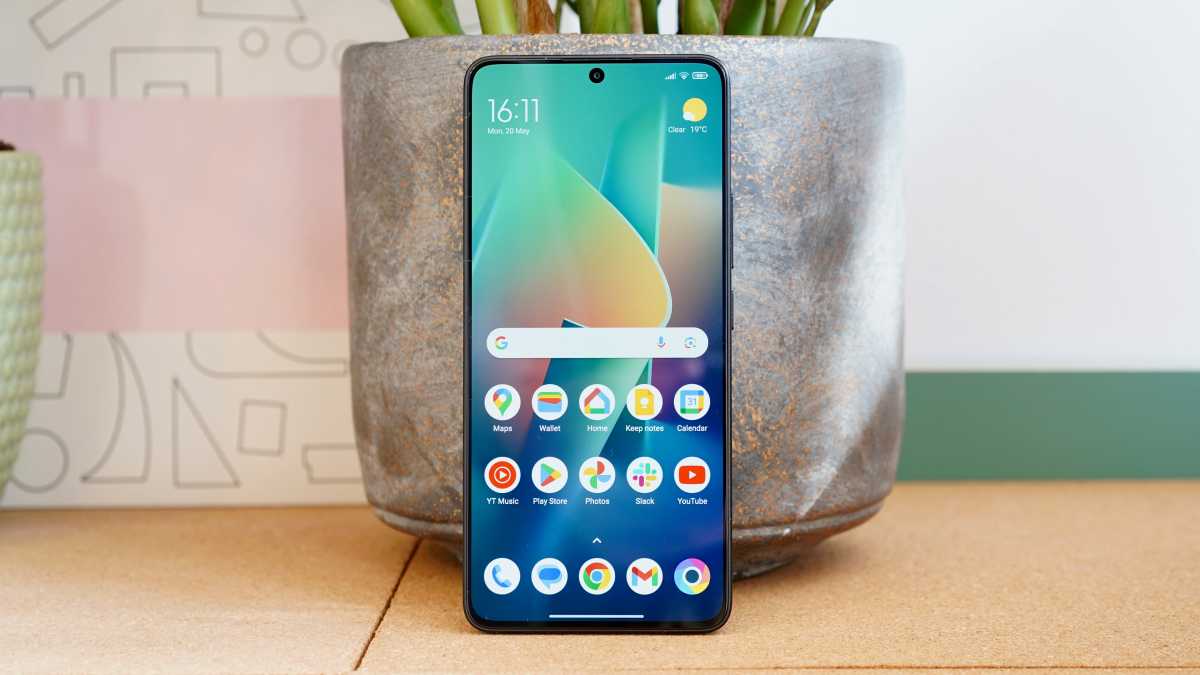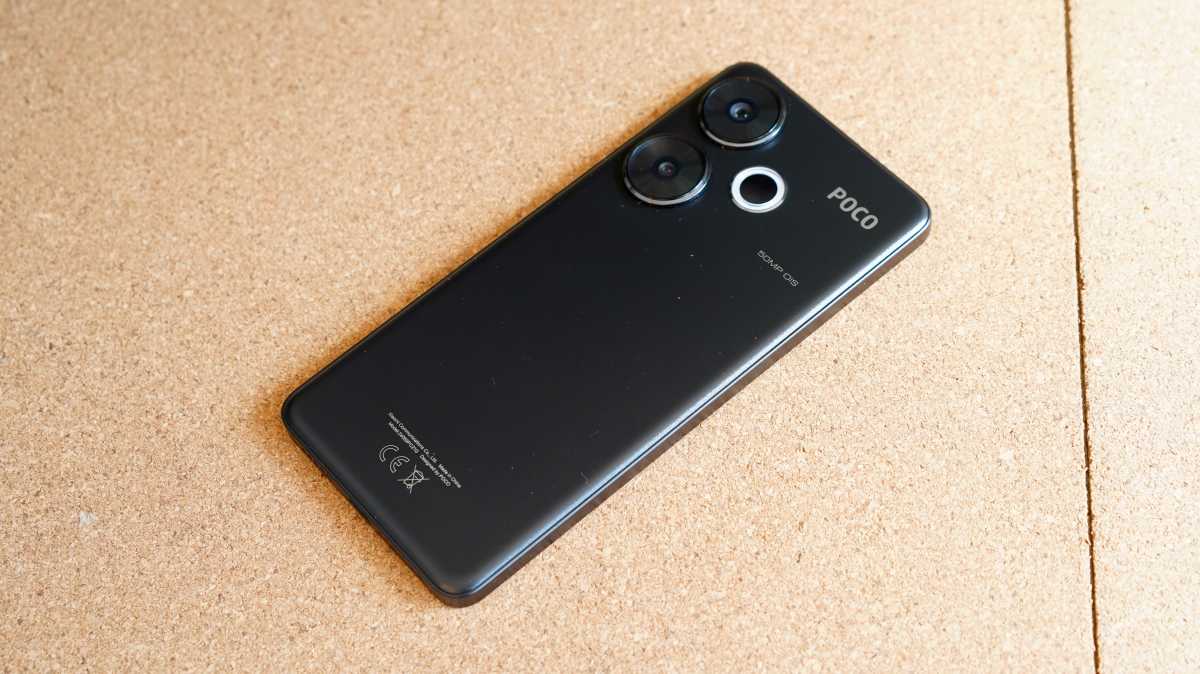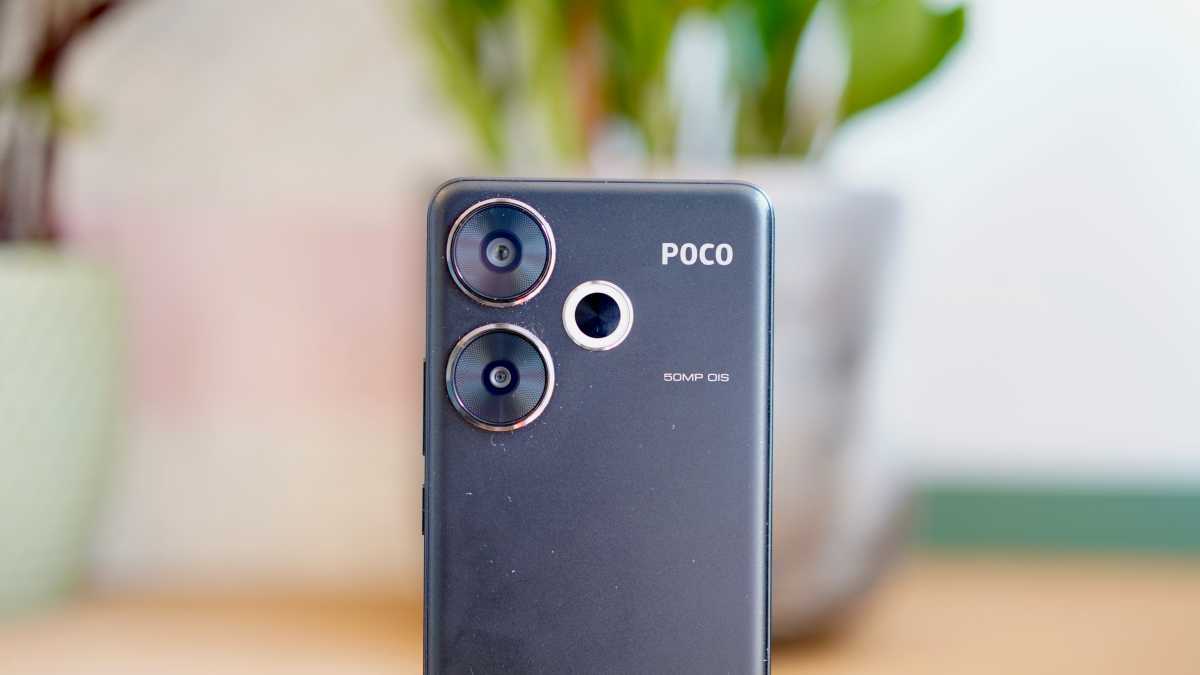Expert’s Rating
Pros
- Outstanding performance
- Excellent screen
- Cheaper than before
Cons
- Bland plastic design
- Unappealing software
- Cameras just OK
Our Verdict
With the Poco F6, the brand has leant into its key strengths, offering phenomenal performance at an even lower price. It hasn’t done all that much to address weaknesses elsewhere, but the Poco F6 remains an excellent option for gamers and performance hounds on a budget.
The name of the game for Poco is performance at a low-to-mid-range price, and the Poco F6 is one of the best examples of this yet. But in a mid-range field that has gotten really strong in the past 12 months, I’m starting to wonder if that’s enough.
Last year we praised the Poco F5 for its potent performance, speedy charging, and reliable battery life, but the simple fact is that our expectations for mid-range phones have risen since then. The likes of the Pixel 7a and the Samsung Galaxy A55 have delivered strong notes of ‘flagship’ for less than £450.
The Poco F6 goes faster and better on the components that make for a compelling media experience – the processor and the display – but is that still enough even with a rare price drop to £399?
if your goal is to get the best performance possible for the least amount of money possible (gamers on a budget take note), the Poco F6 resoundingly hits that sweet spot.
Design & Build
- Drab plastic design
- Improved IP64 certification
- No 3.5mm headphone jack
It’s a case of nip and tuck rather than wholesale change when it comes to the Poco F6’s design, with a familiar – dare I say dull? – all-plastic build.
The frame is flat-edged, while the rear cover has a slight curve to it. My model comes in a rather drab black with the slightest of shimmers. Alternatively, you can opt for Green or the brand-new Titanium.

Jon Mundy / Foundry
Those circular camera modules are way larger than they need to be, though there’s something pleasing about that big ring doughnut of a flash and the open-mouth face it creates when viewed in landscape.
This is a fractionally smaller phone than before by every metric, though at 160.5 x 74.4 x 7.8mm and 179g we really are talking about small differences. It’s solid enough in the hand, and build quality has taken a step forward with IP64 certification and a Corning Gorilla Glass Victus front – two things even the Poco F6 Pro can’t boast.

Jon Mundy / Foundry
However, there’s no getting away from the fact that the Poco F6 doesn’t look or feel as good as other phones in its weight class. Not with the Pixel 8a and the Samsung Galaxy A55 positioned just above it, and the Motorola Edge 40 Neo and the Nothing Phone (2a) just below it.
Bad news for old school headphones users: after restoring the 3.5mm headphone jack to the Poco F5, the firm has once against stripped it out for the Poco F6. In most cases, that’s no longer the major omission that it used to be, but the Poco brand tends to market itself as gamer-focused, and wired headphones are a popular choice.
Screen & Speakers
- 6.67in 120Hz OLED
- 2712 x 1220 ‘1.5K’ resolution
- Colour accurate with plenty of customisation potential
- Stereo speakers
This feels like something of a sweet spot
Poco might not have done much with the basic look of the F6, but fashion was never really this sub-brand’s concern. Where it’s made more meaningful improvements is with the phone’s display.
It’s another 6.67in AMOLED screen with a fluid 120Hz refresh rate, but this time it comes in with a sharper 2712 x 1220 (1.5K) resolution. This feels like something of a sweet spot between FHD+ and QHD+.

Jon Mundy / Foundry
The brightness has also been cranked up, at least in HDR scenarios where the claimed peak has hit 2400 nits. In typical usage that peak is 500 nits, which is about what I recorded.
Xiaomi (still the manufacturing partner for Poco devices) always provides strong colour accuracy with its budget sub-brands, and the Poco F6 hits an sRGB gamut coverage of 96.4% in the suitably title sRGB colour mode, as well as an ideal average Delta E of 1. The phone offers some of the best colour tone-tweaking tools, too, so you can ramp those tones up if you prefer.
There’s proper stereo sound from dual speakers, with one at either end of that display. Stereo separation is good, but the sound lacks the depth and punch of more premium phones – as is typical.
Specs & Performance
- Snapdragon 8s Gen 3
- 8 or 12 GB of RAM
- 256 or 512GB storage
If you’re looking for the fastest phone possible for your £399, this is as good as it gets right now.
Poco phones have always slapped when it comes to performance, but the Poco F6 takes the series to new heights. It’s one of the first phones to use the Snapdragon 8s Gen 3 chip, a slightly stripped back take on Qualcomm’s current flagship SoC found in many flagships.
In a £399 handset, this is quite outstanding. It results in benchmark scores that top even the likes of the Poco X6 Pro and the Pixel 8a, which are two of the more impressive mid-range performers out there.
This manifests in silky performance throughout, with hitch-free navigation, smooth animated home screen transitions, and instant app booting. Straight from set-up, everything pops, and it makes something like the Samsung Galaxy A55, which places its emphasis elsewhere, feel quite wallowy by comparison.

Jon Mundy / Foundry
Fire up an advanced 3D game like Wreckfest or Genshin Impact, meanwhile, and you’ll be able to crank all of the settings up to the very highest they still offer a smooth frame rate.
Poco claims that part of this is down to ‘WildBoost Optimization 3.0’, a custom in-house algorithm that enables high-end gaming performance even at that elevated 1.5K screen resolution. It also points to an IceLoop vapor-liquid cooling system – also found on the Xiaomi 14 – which aims to improve heat dissipation.
Whatever the cause, the Poco F6 is undoubtedly running at nigh-on flagship levels of performance. If you’re looking for the fastest phone possible for your £399, this is as good as it gets right now.
Poco F6 benchmarks
Cameras
- 50Mp main camera with OIS
- 8Mp ultra-wide, 20Mp selfie
- 4K video at 60fps
You should know the deal you’re making when you buy a Poco phone. In return for scorching performance relative to its peers, you will have to accept an at best mediocre camera setup.
The Poco F6 doesn’t change that fact, though that’s not to say improvements haven’t been made. Indeed, with a new 50Mp Sony IMX882 main sensor with an f/1.59 aperture and OIS, it’s a clear step forward from the Poco F5.
But the Poco F6 isn’t really competing with itself, and rivals like the Samsung Galaxy A55 and the Pixel 7a take more accomplished photos.
Close-up food snaps look nice and appetising, even in modest indoor lighting

Jon Mundy / Foundry
Shots taken in good lighting look reasonably vibrant and detailed. Close-up food snaps look nice and appetising, even in modest indoor lighting. A close-up I took of a dandelion made the subject pop with bags of bokeh, and colour tones are generally natural enough – if a little punchy on the green side.
Once the light drops and you activate Night mode, however, the results aren’t too hot. Objects aren’t too distinct, there’s bags of noise in the skies, and I picked up some weird visual artefacts.
The 8Mp ultra-wide really isn’t up to much, serving as much as a placeholder as anything else. Credit to Xiaomi’s tone matching, at least, with a commendable attempt to even out the look of both cameras despite the evident disparity in quality.
Kudos, too, for the ditching of the pointless macro camera. There’re just two cameras here, as there should be.
Selfies from the 20Mp front camera aren’t too bad at all, once you knock that beautifying effect on the head. Sure, they’re a little washed out, but skin tones are reasonably natural, and the Portrait mode separates the subject from the background quite nicely.
One noteworthy side effect of that flagship-derived chip is that you can shoot 4K video at 60fps and super slo-mo 1080p videos at 240fps, which isn’t a common provision at this price.
Battery Life & Charging
- 5000mAh battery
- 90W charging
- Charger and cable included
Poco has once again given the F6 a capacious 5000mAh battery, but it faces a very obvious challenge from the off. That sharper 1.5K display is chucking around a fair few more pixels than before, which invariably places a greater strain on battery life.
Balancing that out is a near-flagship-grade processor with all the energy-efficient trappings that this entails. As such, parity with the Poco F5 would have been a good result.
Parity has not been achieved, but in lighter everyday use you probably won’t notice that. I was routinely able to get through a full 16-hour day of fairly light usage with between 50 and 60% left in the tank, which is roughly the experience I had with the Poco F5 last year.

Jon Mundy / Foundry
When it comes to more intensive usage, however, the Poco F6 drops well short of its predecessor. Its PCMark Work 3.0 Battery Test result of 10 hours and 26 minutes drops 3 hours and 35 minutes short of the F5. Three guesses as to what the culprit for that might be.
One curiosity is the Poco F6’s charging provision which has been boosted from 67W to an even more impressive 90W, but I didn’t see any kind of improved charging times.
Having run the phone right down to empty and hooked up the (bundled in) 90W charger, I found that it took 15 minutes to get to about 41% and 30 minutes to get to 74%. That’s about the same as the Poco F5 – a little worse, even.
It hit a full charge in 48 minutes, which is similar to its predecessor – though still not the 30 minutes that Xiaomi claims.
Once again, there’s no wireless charging here, though we wouldn’t expect that in a phone of this price. The Pixel 7a and Pixel 8a are anomalies in this regard.
Software & Apps
- Ships with Android 14
- New Xiaomi HyperOS, but very similar to MIUI
- Three OS upgrades and four years of security
- Hit and miss AI Air Gesture system
Regrettably, software is once again a weak point with the Poco F6. Just as with the Poco X6 Pro, this is a phone that runs Xiaomi’s new HyperOS on top of Android 14.
This is allegedly an all-new UI, with previous Pocos having run on the outgoing MIUI. In practice, though, precious little has changed. This simply feels like the next version of MIUI with a new name.
You’re talking about a familiar home screen with the customary Xiaomi time and weather widget and app icons. Most of said icons on the primary home screen come from Xiaomi itself, with most of Google’s default applications shoved away in a folder.

Jon Mundy / Foundry
The second home screen contains more applications, including a third web browser in Opera. Xiaomi’s own Mi Browser is on the main homepage, just a couple of inches above Google Chrome. Bloatware’s a problem alright, with a couple of Poco community apps, a Xiaomi smart home app, a folder full of terrible games, and another folder full of unrequested third-party apps also included.
Flick down from the top of the screen and you’ll get, depending on which side you swipe from, either notification centre or a shortcut-filled Control Centre (essentially the iPhone way of doing things). It’s far from the most elegant solution, especially the latter eyeball-assaulting mass of toggles and widgets.
I also experienced several glitches and niggles here. A few WhatsApp notifications didn’t manifest themselves, while I also experienced a mic issue after connecting a set of Bluetooth earphones, requiring me to turn Bluetooth off before I could speak to someone on the phone.
Poco has made something of a big deal about a series of AI enhancements, including so-called ‘AI Air Gestures’. The idea is that the Poco F6’s front camera will detect when you hold your hand up in front of it, then respond to gestures you make to do things like answer calls and control media playback.
The feature is somewhat buried in the Settings menu, and is a little flaky when activated. While the phone would detect my raised hand pretty reliably (if not always instantly), the ensuing gestures were only detected some of the time. The whole process was just too inconsistent and sluggish to make it viable, and only a couple of apps supported it – including the default Music app, which I suspect very few people will use ahead of their chosen streaming app.
On a more positive note, Xiaomi is promising three major Android OS updates and four years of security patches. That’s decent, if not quite up there with Samsung and Google.
Price & Availability
It’s with great pleasure, and no little surprise, to note that the Poco F6 is actually cheaper than its predecessor. Significantly so, in fact.
Part of that is down to a slight tinkering with memory capacities, but only a little. While the Poco F5 started from £449 for the sole model with 12GB of RAM and 256GB, the Poco F6 starts at £399 for 8GB of RAM and 256GB of storage.
There’s now a step-up option, too, which gives you 12GB of RAM and 512GB of storage for £449. It’s this latter top model that I’ve been testing.
As always with Poco releases, there are early bird offers to be had until May 30, with the 256GB variant currently selling for £339 from the official Mi store and Amazon. The 512GB is selling for £369 from the same outlets, though purchasing the latter from a Xiaomi website gets you a gift worth £19.99.
Taking that £399 starting price as the norm, the Poco F6 undercuts the Samsung Galaxy A55 and the Pixel 7a (which is still being sold) by £50, and the Pixel 8a by £100. It’s £50 more than the Motorola Edge 50 Fusion and £30 more than its cousin, the Poco X6 Pro.
Check out our chart of the best mid-range phones for more options.
Should you buy the Poco F6?
With the Poco F6, Xiaomi has stuck resolutely to the path it set out with previous models. Everything here is focused on attaining class-leading performance on a budget.
On those two fronts, in particular, it’s a resounding success. The Poco F6 is faster than anything else you’ll find for this sort of money, or even £100 more. Meanwhile, it’s received a welcome price cut from the Poco F5.
Also praiseworthy is the new 1.5K display, which is sharp, responsive, and colour-accurate. Battery life has taken a bit of a hit as a result though, at least when it comes to sustained or intensive usage.
Elsewhere, the same old gripes keep me from an unequivocal recommendation. The design is a similar case of function over form, the camera set-up – while improved – is still well short of its rivals, and Xiaomi’s software leaves much to be desired.
However, if your goal is to get the best performance possible for the least amount of money possible (gamers on a budget take note), the Poco F6 resoundingly hits that sweet spot.
Specs
- Android 14, HyperOS
- 6.67in, 1.5K, OLED, 120Hz, flat display
- In-display fingerprint sensor
- Qualcomm Snapdragon 8s Gen 3
- 8GB/12/16GB LPDDR5X RAM
- 256GB/512GB storage
- 50Mp, f/1.6 main camera
- 8Mp ultra-wide camera
- Up to 4K @ 60fps rear video
- 20Mp front-facing camera
- Stereo speakers
- Dual-SIM
- Wi-Fi 802.11 a/b/g/n/ac/6e
- Bluetooth 5.4
- 5000mAh battery
- 90W charging
- 160.5 x 74.4 x 7.8mm
- 179g
- Launch colours: Black, Green, Titanium



